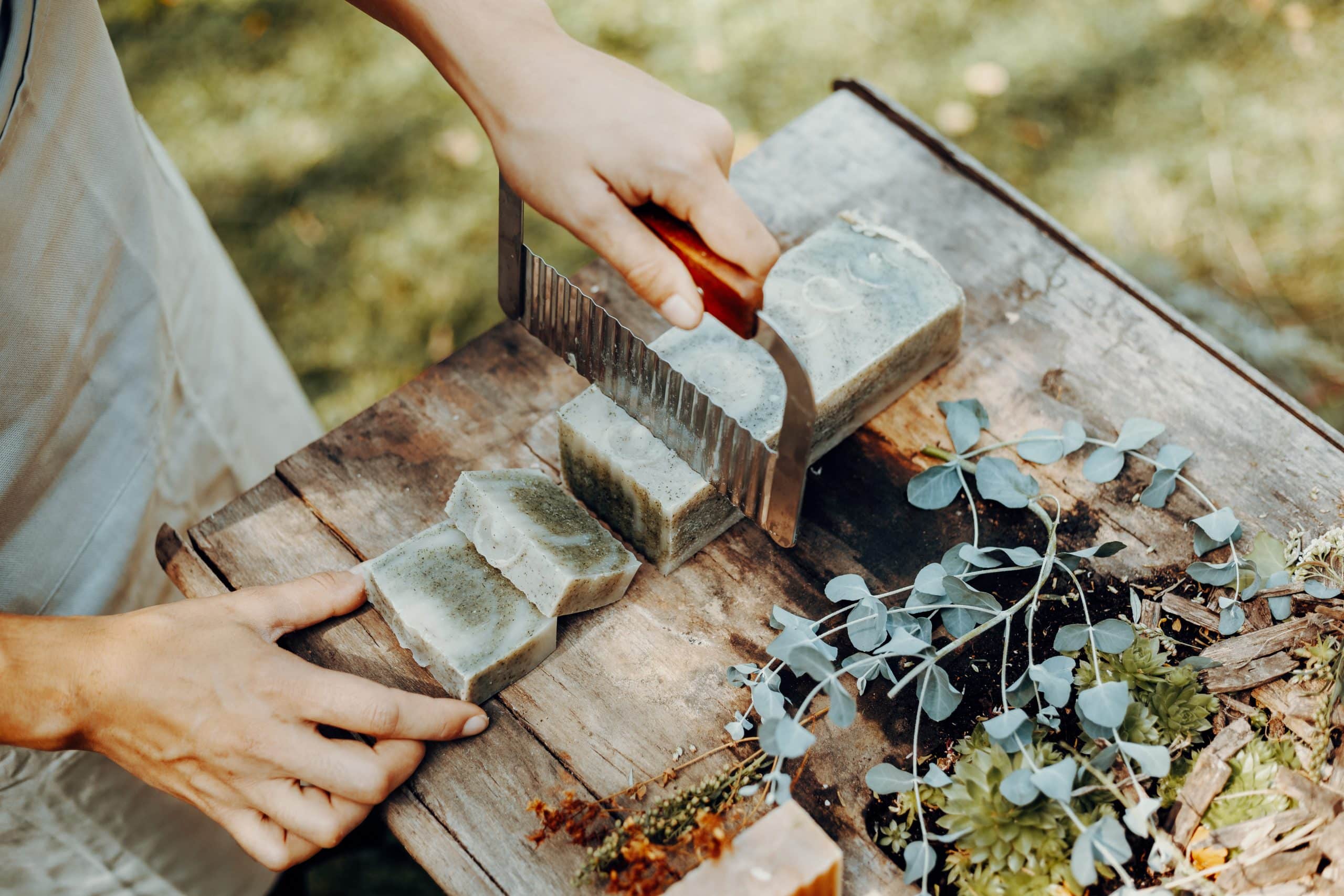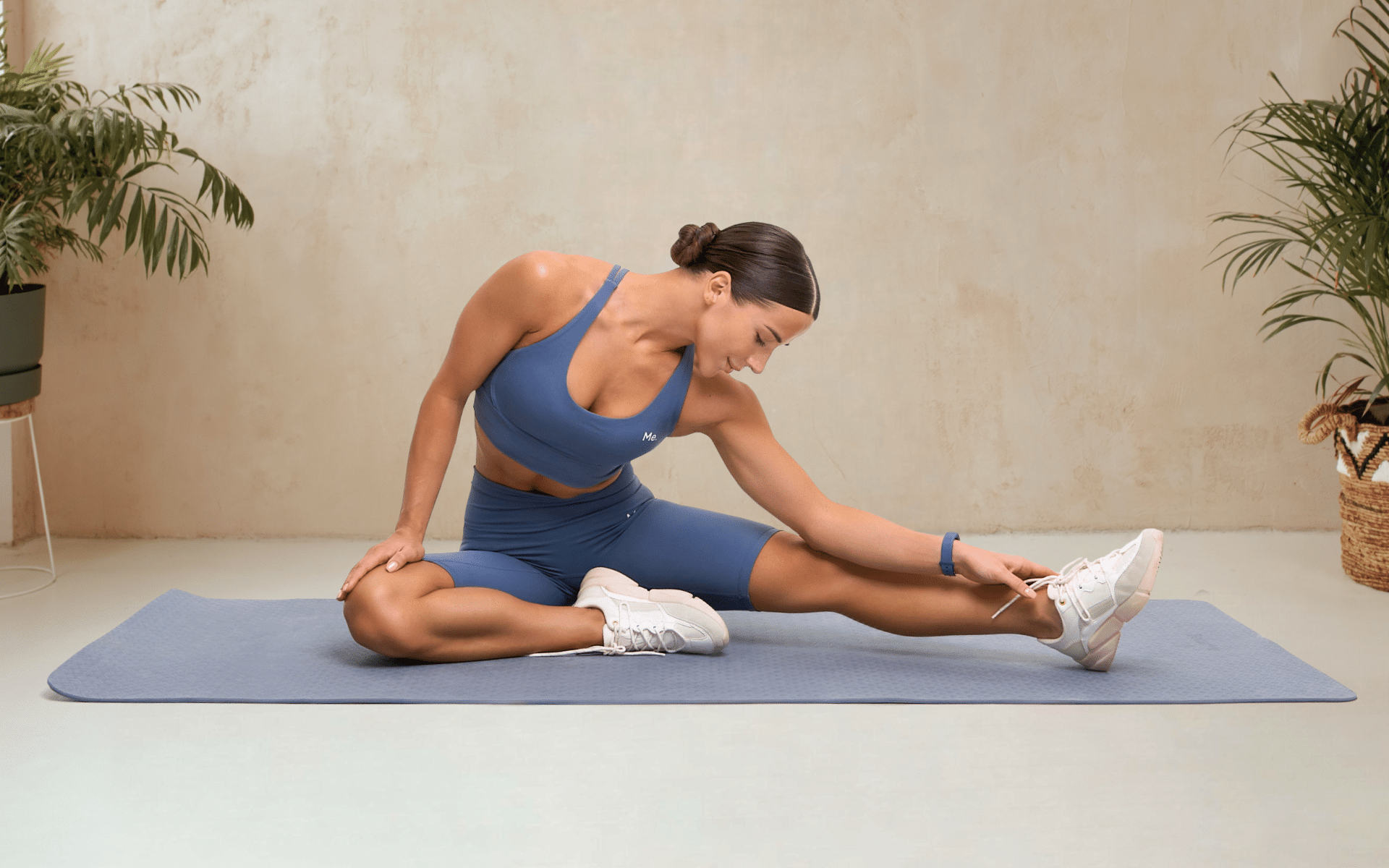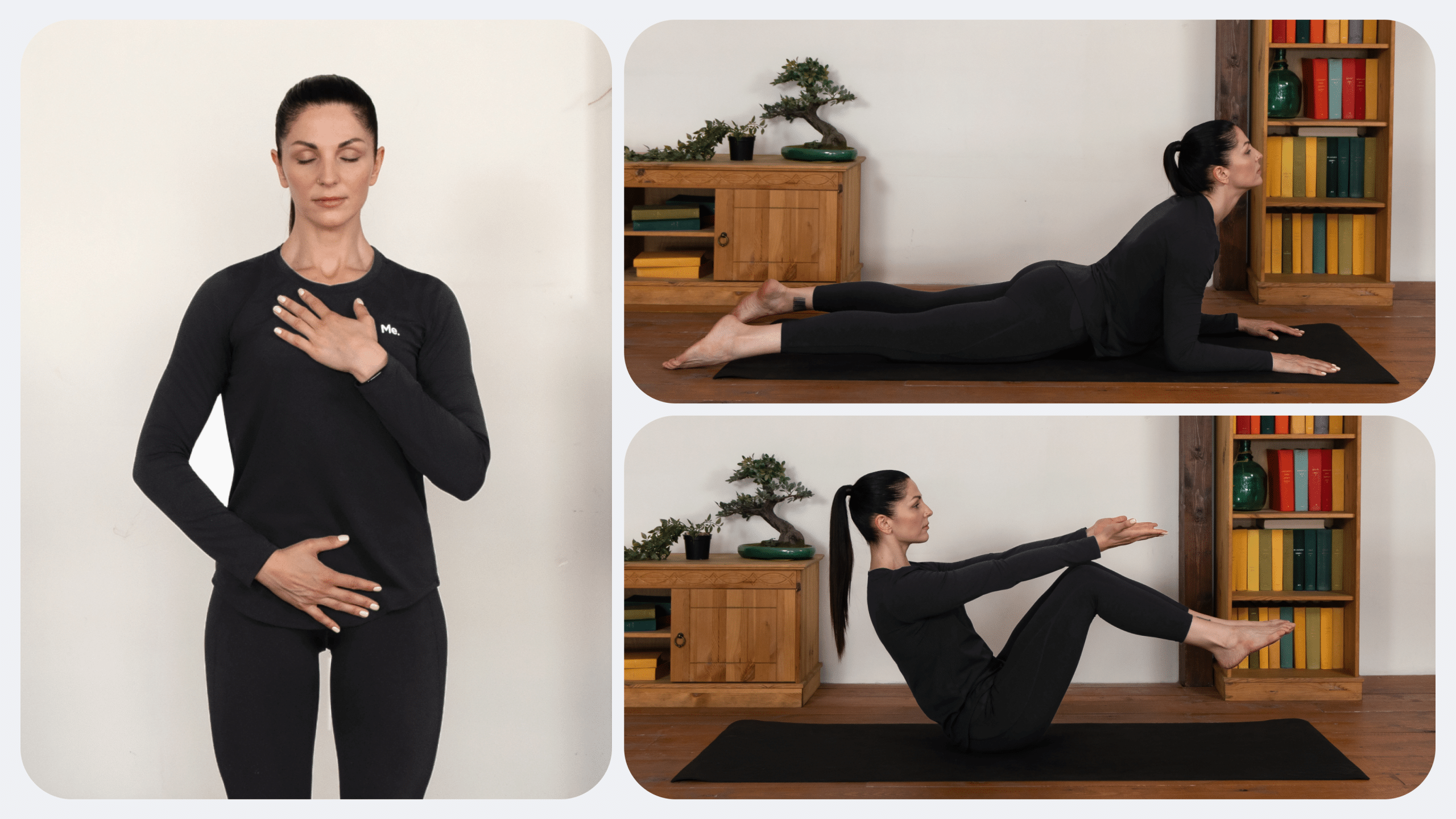Research into massage therapy has yielded interesting findings; some techniques, like deep tissue massage, can help reduce inflammation and relieve muscle tension (8). Others, like Swedish massage, are known to reduce stress and improve overall physical health. It’s also known that including specific ingredients like essential oils, herbs, and natural products can help enhance the therapeutic benefits of massage (18). Recently, massage bars (uniquely formulated soaps that are specifically designed for massage) have become increasingly popular in the massage therapy world. These aren’t your average bar of soap- they are shaped differently (usually one surface has spiked or rounded surfaces to create a massage-like effect), and are made from natural, plant-based ingredients. Curious about the effectiveness of natural soaps, whether they are safe to use and how you can choose the right bar for your needs? Read on!
What Are Massage Soap Bars?
You’d be forgiven for mistaking these for giant Legos. You know, those brick-shaped plastic toys children gleefully build castles with? While both have large round protrusions, massage soap bars are far from being a toy.
Massage soap bars, commonly referred to as massage bars, are thick, natural soaps of various shapes and sizes that are specifically formulated for massage therapy. They’re designed to apply gentle pressure and friction to the skin, muscles and tissues.
By doing so, massage bars can help promote relaxation and enhance the effectiveness of the massage.
DIY lovers are in luck. You can also make your own massage soap bar with just a few easy steps. This can be done by mixing together natural oils, essential oils, or herbs with a natural soap base and molding it into the desired shape.
How Do You Make A Massage Bar Soap?
If you can’t wrap your head around soap having multiple shapes, you’re not alone. Massage bar soap is produced differently than regular bars of soap.
To make a massage bar soap, you need a mold. The mold is usually made of silicone and can create a variety of shapes, depending on your preference.
Once you’ve decided on the shape, all that’s left to do is add the ingredients. You can use a variety of natural oils and essential oils, depending on what you’re looking for. Popular choices are coconut oil, jojoba oil, olive oil, and almond oil.
You can also add herbs like chamomile or lavender for extra therapeutic benefits. Depending on your preference, you can also add natural colorants and fragrances to the mixture.
You’ll select a liquid soap base, which is then combined with essential oils, herbs and other natural ingredients. This mixture is then heated to over 100 degrees and poured into the mold. Finally, it’s left to cool and solidify before it can be cut or shaped into the desired size and shape.
Read More: Explore The Wonders Of Massage Cupping Therapy: A Guide For Newbies
How To Use Massage Bars
Once you’ve chosen the right bar for your needs, it’s time to get started. Before beginning the massage, make sure that the soap is warmed up.
The heat will help the ingredients penetrate deeper into the skin and muscles, increasing the massage’s effectiveness. Once you start massaging, apply gentle yet firm pressure.
The goal is to create friction and an increased blood flow, not to irritate or cause pain. You can use the massage bar to target deep muscle and tissue layers, focusing on problem areas. This can help reduce inflammation and tension in those spots.
Follow these steps for a relaxing and helpful massage experience:
- Start by warming the massage soap bar. This can be done by placing it in hot water or massaging it with slightly warm hands.
- Use gentle but firm pressure to massage the area.
- Focus on problem areas, targeting deep muscle and tissue layers.
- Use the massage bar in circular motions or alternate between up and down strokes.
- If you’re using a massage bar with spiked or rounded surfaces, use those to create friction.
- The motion should be slow and steady, with a continuous flow. Apply more or less pressure as needed.
- The massage should last between 5 to 10 minutes. If you encounter a tense area, you can focus there for a bit longer.
- Finally, make sure to rinse the area with warm water and a cloth.
What Are The Benefits Of Using Natural Soaps For Massage Therapy?
Natural soaps are becoming increasingly popular for massage therapy due to their beneficial properties.
Safe Ingredients
The safety of ingredients in many skincare products has been called into question in recent years. We’re advised to avoid certain chemicals and additives, which can be found in many soaps and massage products.
For example, parabens are often used as preservatives, but they can lead to skin irritation, and even worse, cause a whole range of health problems (4). Another common additive is sodium lauryl sulfate (SLS), which can cause skin irritation and dryness (14).
Fortunately, natural soaps are free from many of these harmful ingredients. These products are created using natural ingredients and essential oils, which can help nourish and protect your skin (3). Not only that, but they can also be more pleasant to use since they don’t contain any harsh chemicals or fragrances.
Better For The Environment
In addition to the benefits for your skin, massage bars can also be better for the environment. Many of these products are made with natural, biodegradable ingredients that won’t harm the planet. This means that when you use them, you’re helping to reduce your carbon footprint.
Soothing Properties
Nature’s bounty also has some soothing properties that can be beneficial for massage therapy.
For example, if you’re looking to relax, lavender is a popular choice. It contains natural antispasmodic, antioxidant and anti-inflammatory properties that can help soothe tight muscles (13).
Other ingredients like chamomile, aloe vera, and jojoba oil also have calming effects that can improve your massage experience.
Anti-Bacterial Agents
Some massage bars also contain anti-bacterial agents like eucalyptus oil or tea tree oil. These ingredients can help to reduce bacteria on the skin and prevent infection (2) (16). This can be especially beneficial if you’re receiving a massage with your partner or in a spa setting.
BetterMe app will kick you out of the mental funk, shake off your extra weight, rid you off your energy-zapping habits, and help you sculpt the body of your dreams. Intrigued? Hurry up and change your life for the better!
Skin Enhancement
Finally, many natural soaps also contain vitamins and minerals that can help to nourish your skin. This can help improve its appearance, making it look and feel softer, smoother, and more hydrated.
For example, aloe vera helps to soothe inflammation while avocado oil and cocoa butter both provide deep hydration, (1) (6) (7).Granted, these benefits can only be enjoyed over time, but it’s still something to consider if you’re using massage bars regularly.
Pain And Stress Relief
Massage bars are also great for relieving stress and easing pain. This is because the ingredients used in natural soaps can help to stimulate the senses and ease tension.
Lavender, for example, has been found to reduce stress levels and create a feeling of calmness (13).
Meanwhile, eucalyptus oil can help to reduce inflammation, which can help ease sore muscles and joint pain (2).
Massaging motions can also help to stimulate the body’s natural healing processes. By gently kneading your muscles and soft tissues, you can increase circulation and improve mobility. This can help reduce tension and fatigue, allowing you to feel more relaxed (17).
Choosing The Right Natural Soap For Massage Therapy
Now that we’ve discussed the benefits of using natural soaps for massage therapy, let’s talk about how to choose the right product.
Read The Label
First and foremost, be sure to read the label carefully. Pay close attention to the ingredients list to make sure they are all natural and free of harsh chemicals. Here are some common ingredients found in natural soaps that are beneficial for massage therapy:
- Coconut oil, which is a natural emollient and helps to create a smooth and silky texture (12).
- Olive oil, which is rich in antioxidants and helps nourish the skin (19).
- Shea butter, which is an extremely moisturizing ingredient that helps to protect and nourish the skin (9).
- Essential oils such as lavender, peppermint, and chamomile, which can provide a calming aroma as well as help to soothe the skin (10).
- Beeswax, which helps to create a protective barrier over the skin and lock in moisture (11).
- Aloe vera, which is a natural anti-inflammatory and helps to reduce redness (1).
- Vitamin E, which helps to protect the skin against environmental damage (20).
It’s also important to look out for any potential allergens or irritants that may be present in the soap. For example, some people may have an allergy to certain essential oils or fragrances, so it’s important to read the label carefully and make sure these are not present (5).
You want to watch out for synthetic colors, fragrances and dyes as these can be harsh on the skin. Additionally, you should also check for parabens and other preservatives, as these can be irritating to sensitive skin (17).
Read More: DIY Facial Massage With A Gua Sha Tool: Benefits, Technique & Tips
Is It Properly Cured?
When it comes to choosing a massage bar, make sure it’s properly cured. Natural soaps require time to dry out and develop their properties.
A bar that’s not properly cured can be overly soft and won’t provide the same quality massage experience. Also, if the bar has not been properly cured, it could contain bacteria or other contaminants.
How would you determine whether a massage bar is properly cured? The easiest way is to look at the packaging. If it doesn’t list how long the product has been curing, you might want to do more research into the brand or contact the manufacturer directly to find out more information.
When In Doubt, Test It Out
Before fully committing to a new soap, it’s always a good idea to do a patch test first. This will help you determine if your skin is compatible with the ingredients.
To do this, simply apply a small amount of the soap to the inside of your wrist and wait 24 hours. If you experience any irritation or redness, it’s best to avoid using the product.
Check Out Reviews
Online reviews can be a great source of information when it comes to choosing the right natural soap for massage therapy. Read through reviews from customers to get an idea of how the product works and how it feels on the skin.
You can also check out ratings from beauty bloggers or industry professionals to get a better understanding of the product.
Take reviews with a grain of salt, however. Everyone’s skin is unique and what works for one person may not work for another.
Lean and toned up body isn’t just a far-fetched fantasy. Check out the BetterMe app and watch it propel your weight loss journey into high gear!
Safety Considerations When Using Natural Soaps For Massage Therapy
When using natural soaps for massage therapy, there are a few safety considerations to keep in mind.
First, be sure to store the product away from heat and direct sunlight. This will help to keep the ingredients from deteriorating and ensure that you are getting the most out of each use.
Next, be sure to wash your hands thoroughly before and after use. This will help to prevent any bacteria or germs from spreading between uses.
Finally, it’s also important to avoid using natural soaps on any open wounds or sensitive areas of the skin. If you are unsure, it’s best to consult a doctor before using the product.
Conclusion
Using natural soaps for massage therapy can be a great way to keep your skin healthy and nourished. With so many options available, it’s important to do your research and choose the product that best suits your needs.
Consider things like ingredients, curing time, and potential allergens before making your final decision. Additionally, it’s important to remember key safety considerations when using these products.
DISCLAIMER:
This article is intended for general informational purposes only and does not serve to address individual circumstances. It is not a substitute for professional advice or help and should not be relied on for making any kind of decision-making. Any action taken as a direct or indirect result of the information in this article is entirely at your own risk and is your sole responsibility.
BetterMe, its content staff, and its medical advisors accept no responsibility for inaccuracies, errors, misstatements, inconsistencies, or omissions and specifically disclaim any liability, loss or risk, personal, professional or otherwise, which may be incurred as a consequence, directly or indirectly, of the use and/or application of any content.
You should always seek the advice of your physician or other qualified health provider with any questions you may have regarding a medical condition or your specific situation. Never disregard professional medical advice or delay seeking it because of BetterMe content. If you suspect or think you may have a medical emergency, call your doctor.
SOURCES:
- ALOE VERA: A SHORT REVIEW (2008, ncbi.nlm.nih.gov)
- Analgesic and anti-inflammatory effects of essential oils of Eucalyptus (2003, sciencedirect.com)
- Anti-Inflammatory and Skin Barrier Repair Effects of Topical Application of Some Plant Oils (2017, mdpi.com)
- A perspective on the safety of parabens as preservatives in wound care products (2021, onlinelibrary.wiley.com)
- Art of Prevention: Essential Oils – Natural Products Not Necessarily Safe (2021, sciencedirect.com)
- Avocado Oil: Characteristics, Properties, and Applications (2019, mdpi.com)
- Cocoa Bioactive Compounds: Significance and Potential for the Maintenance of Skin Health (2014, mdpi.com)
- Deep Tissue Massage and Nonsteroidal Anti-Inflammatory Drugs for Low Back Pain: A Prospective Randomized Trial (2014, hindawi.com)
- Effects of Topical and Dietary Use of Shea Butter on Animals (2014, researchgate.net)
- Essential oils used in aromatherapy: A systemic review (2015, sciencedirect.com)
- Hydration and Barrier Potential of Cosmetic Matrices with Bee Products (2020, mdpi.com)
- In vitro anti-inflammatory and skin protective properties of Virgin coconut oil (2019, sciencedirect.com)
- Lavender and the Nervous System (2013, hindawi.com)
- Long-term repetitive sodium lauryl sulfate-induced irritation of the skin: an in vivo study (2005, pubmed.ncbi.nlm.nih.gov)
- Massage therapy research review (2016, sciencedirect.com)
- Melaleuca alternifolia (Tea Tree) Oil: a Review of Antimicrobial and Other Medicinal Properties (2006, ncbi.nlm.nih.gov)
- Skin safety and health prevention: an overview of chemicals in cosmetic products (2019, ncbi.nlm.nih.gov)
- Swedish Massage: A Systematic Review of its Physical and Psychological Benefits (2017, pubmed.ncbi.nlm.nih.gov)
- Virgin olive oil as a fundamental nutritional component and skin protector (2009, sciencedirect.com)
- Vitamin E in dermatology (2016, ncbi.nlm.nih.gov)


















